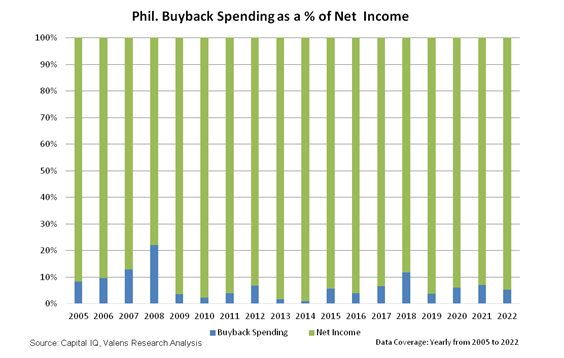PH Monday Macro: Philippine companies are becoming optimistic but US concerns might spillover

We often look at many economic indicators to determine the overall health and future direction of the economy, from consumer sentiment to treasury yields. There’s another important barometer investors sometimes overlook, and that is share buybacks.
Usually, a spike in companies buying back their shares implies the market is steeply discounting equities. This opens up opportunities for investors to buy at or below fair value. However, under different economic conditions, it could also mean something else.
Philippine Markets Daily:
The Monday Macro Report
Powered by Valens Research
When it comes to attempting to measure and determine different companies’ perspectives on the macroeconomic environment, investors commonly use earnings beats/misses and valuation multiples.
The rationale is if the company beats its earnings estimates, there’s a higher chance the industry or economy is in a better position. If a company’s P/E (price-to-earnings) multiple is lower, the company is assumed to be trading cheaply.
However, there’s more to earnings than simply acting as a bottom-line figure. It can also be used as a base for a metric that gauges management sentiment—share buybacks as a percentage of net income.
A company’s share buyback program provides investors with critical information on what the management thinks. Depending on the circumstances, it can actually mean either of two things.
If the market isn’t doing well, and management opts to buy back shares, it can signal to investors that management thinks the company’s shares are undervalued. This normally leads to higher stock prices because of the positive sentiment gleaned from management believing the stock is trading at a bargain.
On the flip side, if the market and economy are both doing well and management initiates its buyback program, this signals to investors that there might not be any near-term growth opportunities for the company. After all, if the company still had growth potential, management would be opting to invest in those instead of buying back shares.
Let’s take a look at the share buyback behavior of Philippine companies.
As the chart shows, Philippine management teams bought back a large percentage of shares during the global financial crisis in 2008. Though the country itself did not enter into the recession that the rest of the world did, we still felt the contagion effects of the crisis.
Share buybacks as a percent of net income jumped to over 20% in 2008 before settling in lower levels the following years after. It increased considerably again in 2018, which hinted at a possibility that companies were running out of growth opportunities, as no major economic concern plagued the country.
Then in 2020, because of the uncertainty of the pandemic, panic-selling among investors led to depressed valuations, and the percentage of share buybacks in proportion to net income rose 6.0%.

Subsequently, in 2021, share repurchasing increased to 7.0%. Now, with 2022 done, the percentage of companies buying back their shares is down to 5.3%.
Generally, a climb in share repurchases does not necessarily mean the economy is heading for a recession. It simply suggests that companies are going through a difficult time, and what better way to captivate their shareholders than by making their stock look attractive?
Coming into the new year, since the amount of buybacks in proportion to net income decreased, it could imply companies are becoming more optimistic about their business environment.
Now, if share buyback activities among Philippine companies eased, it gives positive signals because the environment that they are in will either make the performance go sideways or improve.
However, U.S. companies tell us a different story. Similar to Philippine companies, share repurchases as a percentage of net income picked up in 2020 and contracted in 2021, 58.7% and 48.7%, respectively.
Yet, instead of declining in 2022, it spiked to 59.2%, a figure greater than in 2020. This indicates perhaps growing concerns about the economy. To name a few, the Federal Reserve is trying to engineer a soft landing and the impact of geopolitical issues on the global supply chain.
It’s interesting to see how management teams in the Philippines will react in the coming months, given the U.S.’s buyback behavior. After all, the U.S. is the largest economy in the world, so any financial concerns there will likely have a contagion effect on the country, though we can’t say yet to what degree the impact will be.
About the Philippine Markets Newsletter
“The Monday Macro Report”
When just about anyone can post just about anything online, it gets increasingly difficult for an individual investor to sift through the plethora of information available.
Investors need a tool that will help them cut through any biased or misleading information and dive straight into reliable and useful data.
Every Monday, we publish an interesting chart on the Philippine economy and stock market. We highlight data that investors would normally look at, but through the lens of Uniform Accounting, a powerful tool that gets investors closer to understanding the economic reality of firms.
Understanding what kind of market we are in, what leading indicators we should be looking at, and what market expectations are will make investing a less monumental task than finding a needle in a haystack.
Hope you’ve found this week’s macro chart interesting and insightful.
Stay tuned for next week’s Monday Macro report!
Regards,
Angelica Lim
Research Director
Philippine Markets Newsletter
Powered by Valens Research
www.valens-research.com




